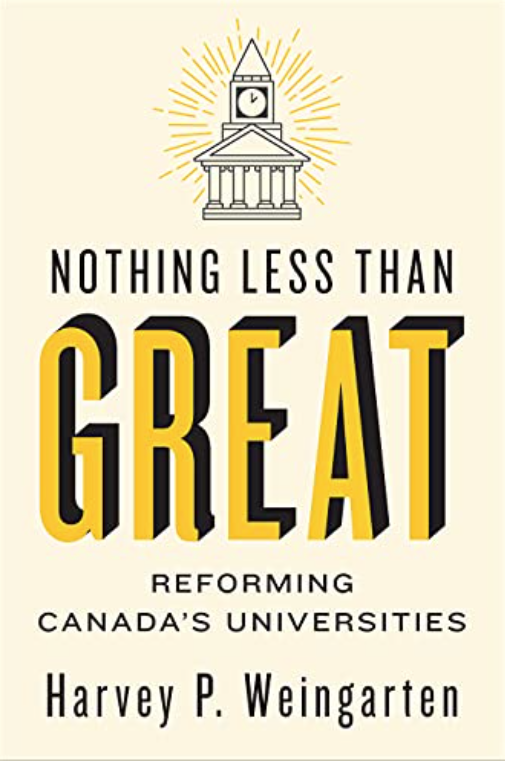Personal experiences breed and nourish intellectual views. Harvey P. Weingarten tells his readers about the benefits he and his wider family received from Canadian universities. He evokes the past with a sense of gratitude, but turns to the present and the future with acute concern. He is concerned because, in his eyes, Canada’s public higher education system is in trouble: the quality of education is declining, the willingness and capacity to innovate are unsatisfactory, and many institutions are financially hardly sustainable. He believes that his long involvement in higher education makes him competent to propose observations about the existing state of affairs and recommendations for future reforms. He argues that improving the current higher education system is a rewarding investment in Canada’s future; it will further enhance the country’s economic wealth and culture of civility.
With this particular mental framework, Weingarten discusses the operation of universities and elaborates on the objectives and methods of possible reforms. These have to take into account the needs of citizens, businesses, and public institutions that directly benefit from university teaching and research. Admittedly, students, corporations, and governments prefer to envisage university affairs in terms of investments and returns.
Before choosing a field of study and sending an application to the registrar’s office, students tend to ask: what kind of professional and financial benefit will I obtain after earning a university degree? Will my acquired skills respond to the current needs of a profession? Government officials and business leaders raise similar questions: What are the most relevant skills needed in a dynamic labour market shaped by the proliferation of technological devices? Will university graduates acquire specific job-related skills? How can universities produce economical benefits? Will they be able to adjust to the expected social and economic changes? Moreover, if they are able to introduce innovative teaching and research activities, then, what sort of resources will they need to pursue their operations and to reach their objectives?
Weingarten believes that the social benefits of Canadian universities are not sufficiently known and recognized. Therefore, administrators are advised to disseminate, as widely as possible, the indisputable relationship between a sound university education and future higher earning. Their message should be simple and straightforward: if you want to become more prosperous and lead a healthier life, get a university degree. However, the promised and achieved prosperity and health should not be reserved only to those students who already enjoy an advantageous financial situation. Universities must encourage and facilitate, by various means (financial assistance, academic support, and judicious program designs), the enrollment of members of “under-represented groups.” What matters is allocating funds to programs, which are designed with the express purpose of narrowing the current “equity of access gap.”
Once students are enticed to enroll, what should they learn in their classrooms and laboratories? If the primary desire of the student is to get a job, the university should do more than merely transmit specialized knowledge. What is required is the development of transferable cognitive skills, such as critical thinking, and behavioural skills, such as the ability to work well with others and communicate thoughts and directives efficiently. No less important are the “employment-related skills.” Experiential learning programs must be put into place in order to acquire and perfect those skills which are expected and demanded by employers. Clearly, companies and enterprises want to employ graduates who acquire the ability of taking initiatives and of solving problems in the ever-changing working environment.
In this respect, Weingarten refers to the gap between the skills expected by business leaders and the skills institutions succeed imparting. The gap produces a general dissatisfaction in the employers and a sense of inadequacy in the graduates. Weingarten reports in great detail the pressing concerns and requirements of workplaces. He applauds the initiatives of those university administrators who, by throwing back the ball to the employers’ court, demand them forcefully to take their own lion share in the instruction of students and, thus, to meet the university halfway. He admits, however, that these “co-op initiatives” do not receive enough support from the teaching staff as well as from members of the community and unimaginative business leaders.
The successful acquisition of knowledge and skills required for the students’ seamless entry into the job market will indicate the quality of teaching, of programs, and students’ learning experience. A university will earn a high rating when it responds to the primary need of the students: getting a job instead of stepping out of the campus into a vacuum. If a university succeeds in tailoring its programs of study and research in this sense, it fulfills its chief mission. “The point has been repeatedly made throughout this book that a dominant need of the students who choose to attend university is to obtain the education and credential required to secure and succeed in a good job.”(157)
The governments, allocating public funds, present expectations and regulations to universities. They exercise, although indirectly, a control over the major expenditures of universities. “Contrary to the beliefs of many,” Weingarten observes, “that Canada’s universities are autonomous institutions, the reality is that higher education in this country is a highly regulated industry.”(83) In principle, each industry gets its funding according to the achievement of previously established performance goals and expectations. A reform should consider the flexible relationship between the expected performance and the particular characteristics and orientation of the university.
To what extent can the governments support universities operating steadily increasing costs? What universities can do to decrease their expenditure and make themselves financially sustainable? These vital questions are also raised in this book. Turning to the government for more financial support does not provide the right answer. Weingarten contends that the capacity of governments to finance university education has reached a limit.
One of the foreseeable solutions consists of reviewing the workload and productivity of the faculty and insuring an equal distribution of work assignments. However, raising concerns about the possible uneven contributions of the faculty will most likely meet the resistance by the various unions. In this respect, the author fails to recognize the powerful role played by these unions in shaping any desire of introducing changes in the operation of universities. The fact that unions actively support and nurture the widespread unwillingness to espouse administrative and academic reforms receives scant attention in this book.
As I have said earlier, the author understands the nature and purpose of the university through the prism of rationalization, expediency, financial benefit, productivity, and adaptation to industry. In his view, universities tend to resemble efficient factories imparting and “credentialing” skills and competencies to their consumers. Just like any other “highly regulated industry,” universities are required to carefully manage their financial resources and, at the end of each academic year, create a satisfying balance between investments and results.
After closing this book, the reader might raise the questions: should today’s universities privilege the adaptation to the prevalent economic conditions? Should they focus exclusively on preparing students for today’s job market? Should government officials assess the quality of a university education merely with the yardstick provided by the current economic system? Should the students, professors, and administrators endorse obediently such a strictly expedient understanding of post-secondary education?
Our answer is affirmative if we subscribe to Weingarten’s conception of higher learning in a postsecondary institution. What is the gist of this conception? Weingarten tells the reader that the subject of his book is university education. But what his book is really about is the technical training offered in technical colleges, in these otherwise vitally important postsecondary institutions. The training consists essentially of imparting all the skills, proficiency, and knowledge necessary for graduates to successfully function in a specialized profession somewhat like being an automobile mechanic. Thanks to a carefully designed training, students become qualified educators, dentists, accountants, pianists, psychologists, journalists, jurists, architects, translators, or urologists. In short, they have acquired the expertise to secure a job and to make the economy thrive. Expert “professors” have provide them with the relevant and useful training. These experts are required to be competent in their respective fields and to know how to develop efficiently students’ skills that eventual employers look for.
This is all good, but what is, then, education as opposed to mere training and what is a university as opposed to a finely-focused technical college?
This is a huge topic, which is impossible to cover adequately in a short book review. I would merely advance a few remarks on three activities that, in addition to the obvious material and financial resources, are essential for a genuine university: nurturing a sense of vocation, promoting contacts with models, and creating occasions and spaces for the practice of the art of conversation.
A “great university,” to use Weingarten’s expression, aims at inspiring students, evoking in them a shared passion for a field of study and taking on a profession with a strong sense of vocation. Passion is a contagious disease and may be acquired through reading, traveling, conversing with a friend or a parent, but also through taking the courses of a teacher who knows and loves his or her subject and is able to reveal all the captivating and challenging aspects of a field of study. The infectious influence often prompts the student to explore a subject in depth. Obviously, there is a difference between considering a profession as a means of earning a living and viewing it as a fulfilling vocation. A vocation (of healing people or of designing comfortable and aesthetically pleasant houses, for example) allows the students to identify themselves with a discipline, to discover and fructify their personal talents, to achieve the satisfying realization of their potentialities, to become more fully human. A vocation conveys an agreeable and persistent feeling of agreement between what one is called to do and what one is able to do. Hence the primary task of university teaching is not merely preparing students for a good job and contributing to economic growth (people rightly defend the value of training for jobs and growth) but also, and chiefly, evoking in students a sense of higher purpose, an intellectual hunger, and a passionate involvement in the chosen career.
The above-mentioned inspiration may come from the beauty and wealth of a subject or from the personality of the teachers. Or from both. Teachers at a “great university” master their discipline and aspire to become role models for their students. In our context, a model is a teacher who, due to his or her perceived qualities, values, and achievements, exerts a profound and transformative influence on students. A profession, a lifelong interest, or a form of existence may be adopted following contact with such a role model. (Many famous scientists, in fact, drew attention to the debt they owed to their teachers.) A person’s identity, social role, and way of life are strongly affected under the influence of a model. The teacher’s impact may extend beyond classroom activities. It may offer both guidance and a framework for making the right life-course decision. It may help to specify the person’s moral outlook and insight into what is good and what is evil and what it means to live a good life.
The philosopher Michael Oakeshott believed that universities betray their mission if they overlook one of the fundamental traits of human beings: “the ability to participate in a conversation.” “A university will have ceased to exist when its learning has degenerated into what is now called research, when its teaching has become mere instruction and occupies the whole of an undergraduate’s time, when those who came to be taught…come with no understanding of the manners of conversation but desire only receiving a qualification for earning a living or a certificate to let them in on the exploitation of the world.”1 At a vibrant and “great university,” open-minded intellectual debates, free discussion among teachers and students, and personal contacts are integral part of the education. Many graduates correctly believe that they have learned as much from these unconstrained exchanges as from lectures, books, and laboratory experiments. Alfred N. Whitehead attended lectures on mathematics, pure and applied. “But,” he writes, “lectures were only one side of the education. The missing portions were supplied by incessant conversation, with our friends, undergraduates, or members of the staff.”2 The ubiquity of cell phones and other technological devices tends to eradicate from the campuses the beneficial art of conversation. Yet, conversation makes the students learn to see things with the eyes of their partners, from a different point of view, and to overcome the persistent temptation of oversimplification and exclusion. It helps them to clarify and formulate ideas and, perhaps more importantly, to propose original insights. As the French say, l’appétit vient en mangeant, l’idée vient en parlant. While engaging in a conversation, students not only learn something, but also acquire the intellectual and moral habits appropriate for serious conversations: they learn to listen, to reason, to speak well and with ease, to grasp a problem from various angles, to tie abstract ideas to living realities, to treat others with tolerance and respect, and to formulate demands in a tactful manner. Students also learn that face-to-face conversation constitutes the primary condition of desirable civic activities in a democracy. One of the principles that should guide conversation is maladjustment, rather than adjustment, to what a wider social context prescribes people to follow. Maladjustment means that both students and their teachers approach social institutions, economic practices, and dominant ideologies with a free and critical mind: they free themselves from the ingrained and habitual ways of seeing the world.
The Canadian literary critic and former university principal Northrop Frye once called the university “a powerhouse of freedom.” It means that “there must be a continuous current of mental energy flowing into the world from the university.”3 This current represents what a university stands for in face of economic and social constraints and what graduates are able to achieve once they have obtained their degrees. Graduating students can carry this creative and critical energy into the world and they are able to apply it. This energy is in the artist’s vision, in the scientist’s experiment, in the teacher’s lecture, in the politician’s policy, in the nurse’s care, in the engineer’s design, and in the social worker’s patience. And, of course, this energy should also exert its influence in the effort of defining the future objectives and activities of Canadian universities.
Gabor Csepregi is a visiting scholar at St. Paul’s College, University of Manitoba and past president of Université de Saint-Boniface. He has published extensively on philosophical anthropology.
Endnotes:
- Michael Oakeshott, “The Idea of University,” in The Voice of Liberal Learning, New Haven: Yale University Press, 1989, 104.
- Alfred North Whitehead, “Autobiographical Notes,” in Essays in Science and Philosophy, New York: Philosophical Library, 1948, 10.
- H. Northrop Frye, By Liberal Things, Speech on the occasion of his installation as Principal of Victoria College, University of Toronto, October 21, 1959. Toronto: Clarke, Irwin & Company, 1959, 18-19.



